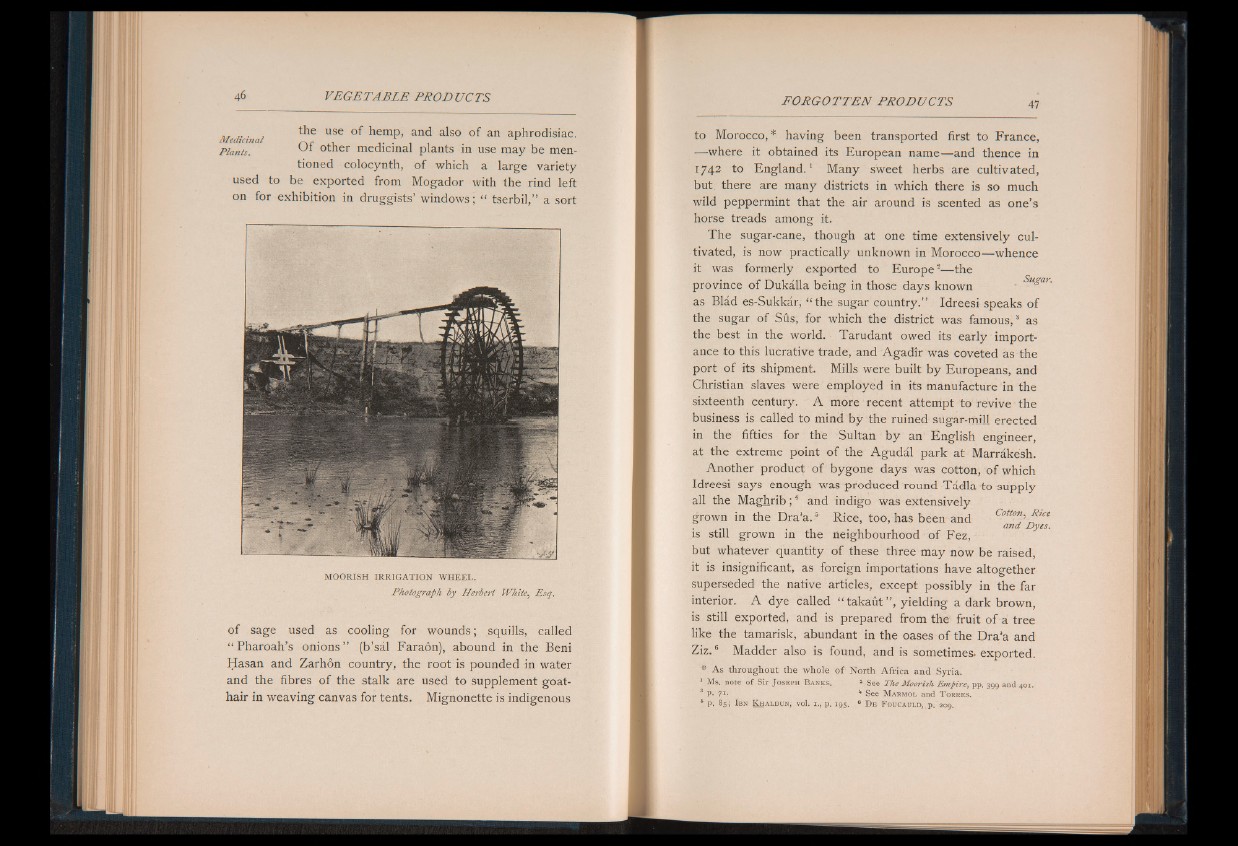
use o f hemp, and also o f an aphrodisiac.
Meatctnal r. c ., . . . . . .
Plants. tJi other medicinal plants in use may be mentioned
colocynth, of which a large variety
used to be exported from Mogador with the rind left
on for exhibition in druggists’ windows; “ tserbil,” a sort
MOORISH IRRIGATION WHEEL.
Photograph by Herbert White, Esq.
of sage used as cooling for wounds; squills, called
“ Pharoah’s onions” (b’sal Faraon), abound in the Beni
Hasan and Zarhon country, the root is pounded in water
and the fibres o f the stalk are used to supplement goat-
hair in weaving canvas for tents. Mignonette is indigenous
to Morocco,* having been transported first to France,
-—where it obtained its European name— and thence in
1742 to England.1 Many sweet herbs are cultivated,
but there are many districts in which there is so much
wild peppermint that the air around is scented as one’s
horse treads among it.
The sugar-cane, though at one time extensively cultivated,
is now practically unknown in Morocco— whence
it was formerly exported to Europe2— the
province of Dukalla being in those days known
as Blad es-Sukkar, “ the sugar country.” Idreesi speaks of
the sugar of Sus, for which the district was famous,3 as
the best in the world. Tarudant owed its early importance
to this lucrative trade, and Agadir was coveted as the
port of its shipment. Mills were built by Europeans, and
Christian slaves were employed in its manufacture in the
sixteenth century. A more recent attempt to revive the
business is called to mind by the ruined sugar-mill erected
in the fifties for the Sultan by an English engineer,
at the extreme point of the Agudal park at Marrakesh.
Another product of bygone days was cotton, of which
Idreesi says enough was produced round Tadla to supply
all the Maghrib;4 and indigo was extensively
grown in the Dra’a .5 Rice, too, has been and Cotton-,
.. and Dyes.
is still grown in the neighbourhood of Fez,
but whatever quantity of these three may now be raised,
it is insignificant, as foreign importations have altogether
superseded the native articles, except possibly in the far
interior. A dye called “ takaut ” , yielding a dark brown,
is still exported, and is prepared from the fruit o f a tree
like the tamarisk, abundant in the oases of the Dra’a and
Ziz .6 Madder also is found, and is sometimes, exported.
* As throughout the whole of North Africa and Syria.
1 M s. n o te o f S i r J o s e p h B a n k s . 2 S e e The Moorish Empire^ p p . 399 a n d 401.
3 P* 7 1 - 4 S e e M a rm o l a n d T o r r e s .
5 P. 8 5; I b n K h a l d u n ; v o l. 1 ., p . 19 5. 6 D e F o u c a u ld , ,p . 209.